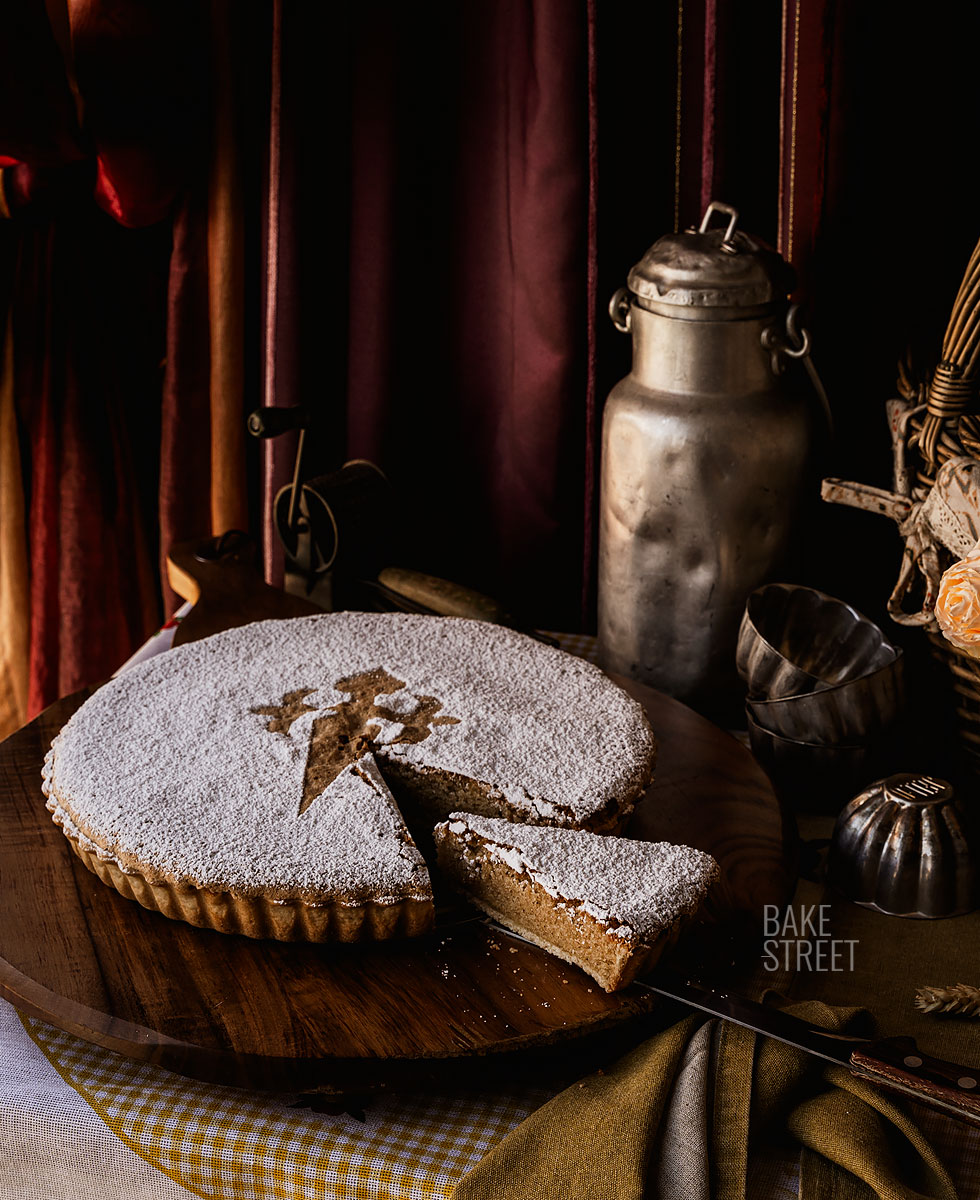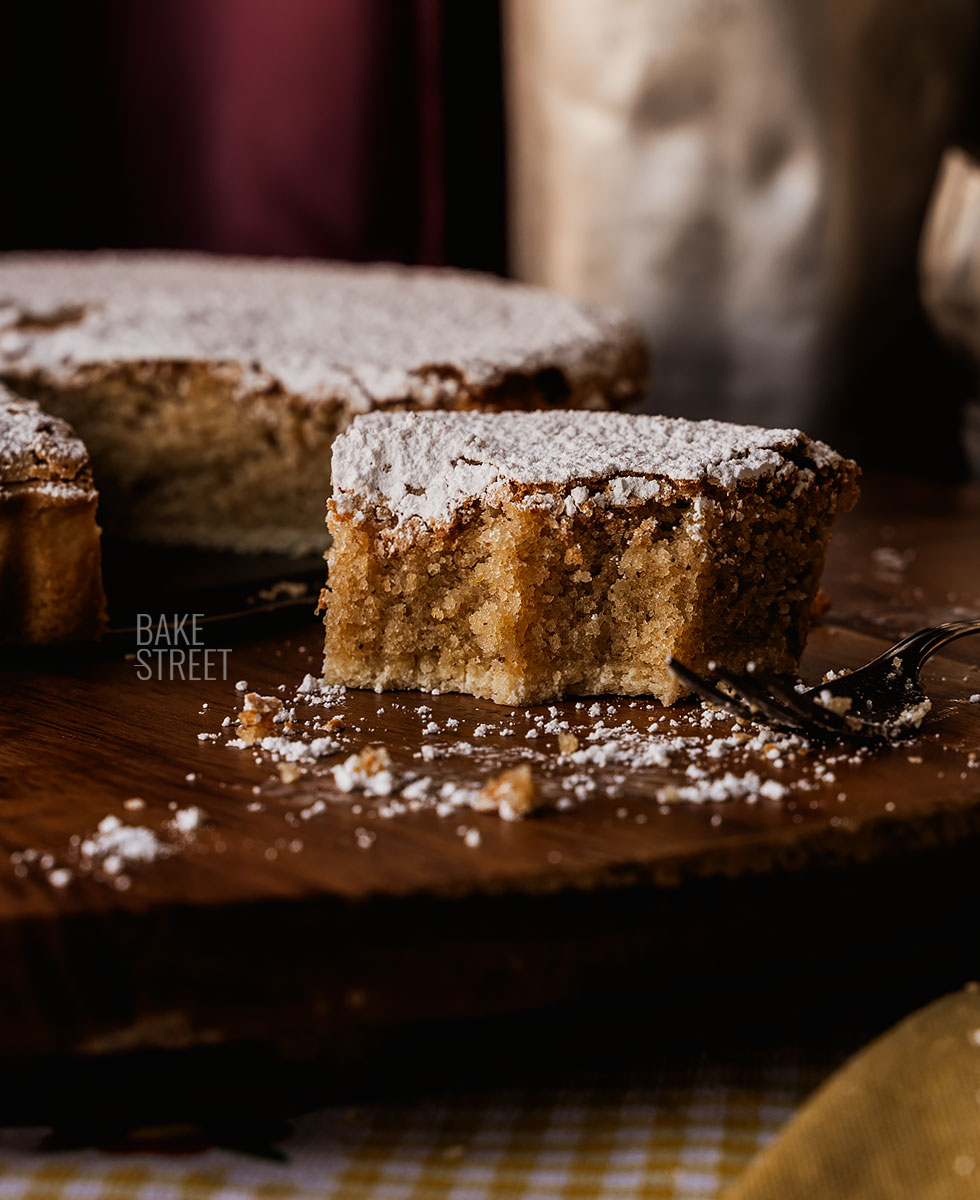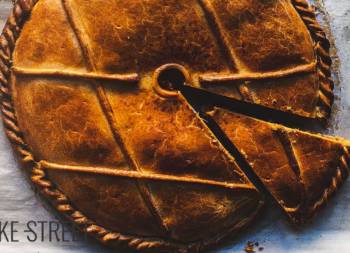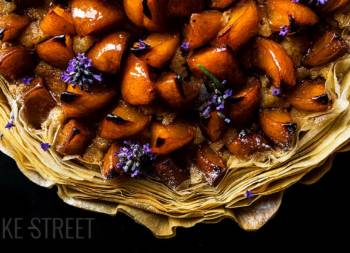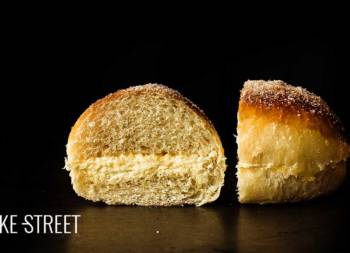
Tarta de Santiago, Galician almond cake
I have been several times in Galicia and whenever I have had the pleasure of visiting it, I have always eaten Tarta de Santiago, Galician almond cake. Well, I have eaten many other things because its gastronomy is fabulous, as in all the north of Spain. With this I don’t mean that in the rest of the peninsula they eat badly, not at all (which in Huelva we have enjoyed incredibly). But the north has that “Je ne sais quoi” that makes you come back with a feeling of fullness. This tart, despite being incredibly simple, has always stolen my heart. Its flavor, aroma, moistness… I fall in love with it.
I have the same feeling as the previous week with the Gâteau Basque. It is incredible how we can elaborate wonderful recipes with very few ingredients. But, it is true that, on this occasion, we use a star element; the almond. It is difficult to prepare something with almonds and for it not to be good. But, I assure you, it is a sweet that you can’t miss if you haven’t already tried it.
Almonds in Galicia.
Although there are hardly any almond trees in Galicia, its consumption and trade can be attested since the late Middle Ages. It was imported by sea from the lands of the Spanish Levante. Its use admits two variants: therapeutic and as a gastronomic ingredient.
Due to its scarcity and high price, the almond was a food consumed preferably by the richest, especially as an after-dinner snack. This connotation of prestige was maintained during the second half of the 19th century, when almonds began to become popular and crystallized what is known today as Galician regional cuisine. In Galicia, its status as an ingredient that brings refinement to any dish and any sweet is maintained even today.
The Tarta de Santiago has its roots in the oldest traditions of Galician pastry-making. In it, the almond, together with other expensive condiments such as sugar, is a fundamental and typical ingredient, to the point that it could be said that the profusion of sweets with almonds is something distinctive of the desserts of the Galician wealthy tables at least since the sixteenth century.
There are also records for its medicinal use in the infirmary of the Colegio Mayor of the University of Santiago, according to its expense account:
En treze de abrill ocho maravedís de açúquar y ocho de almendras para un pisto… (1577)
There is also a register of menus for patients:
Recétasele al licenciado Juan García para su dolor de costado dos bizcochos para el desayuno, media libra de carnero y una fada para la comida, un par de huebos passados y una almendrada y un par de fadas para la çena… Santiago y noviembre, 8 de 1688
Origin and history of the Tarta de Santiago, Galician almond cake.
Among the many specialties historically attested, the most widespread today is, along with almond cakes, the sponge cake or almond cake. Among these, Tarta de Santiago stands out.
The most immediate precedent of this pastry could be found in the torta real, consumed in the University of Santiago as early as the 16th century (1577). Unfortunately, there is not enough reliable data to relate this pastry to the current Tarta de Santiago in both its composition and preparation.
Known throughout the Ancien Régime as torta real or bizcochada, the information available today suggests that it was a sponge cake made with ground almonds, sugar and eggs, baked in the oven and served in a single piece or cut into individual portions.

Other background information that should be taken into account.
They are the wide range of almond sponge cakes that, in the form of mantecados, cakes or sponge cakes, were consumed in the houses and institutions of Galicia in the most important celebrations since the sixteenth century.
El Cuaderno de confitería by Luis Bartolomé de Leybar, written around 1838 and of Galician origin, contains the first reliable information about this dessert, which he calls “vizcochos de almendras” (almond sponge cakes).
El confitero y pastelero: libro muy útil para los jefes de casa, fondistas y confiteros by Eduardo Merín -published in Ferrol in 1893-, provides a second recipe for this pastry which, under the name “Tarta de Almendra“, is decorated with a thin layer of ground sugar and contains a dough base made with butter, flour and sugar.
The sponge cake or almond cake, called from the first decades of the twentieth century “Tarta de Santiago“, is also one of the formulas included in the Diccionario general de cocina (1892) by Ángel Muro and, of course, in the classic works of Galician cuisine as La cocina gallega (1905) by Picadilloand, later, by authors such as Álvaro Cunqueiro or Fina Casalderrey. All of them, however, are unaware of Leybar and Merín’s compilations.
This dessert, with an intense historical tradition in Galicia, acquired its definitive form in 1924, when José Mora Soto -founder of the Casa Mora in Santiago de Compostela- decided to decorate his almond cakes with a silhouette of the cross of Santiago, uniting in this gesture a symbol of the city and a traditional specialty.
This is the famous format with which we all know this traditional and classic Galician pastry delicacy.
Making Tarta de Santiago Galician almond cake.
It is a recipe that has no mystery. It is true that we can find many formats where only the almond cake is made. But, if you allow me, this thin and crunchy dough base is a perfect finishing touch for this cake. In addition to containing the cake, it prevents it from sticking to the mold.
As in any process of elaboration, there are many methods. In my case I leave you with the one that I consider gives the best results in terms of flavor, texture and moistness.
The eggs can be incorporated as they are, mixed with the rest of the ingredients and poured into the mold or, alternatively, we can whip them, thus achieving an airy, light, light and wonderful consistency. Of course, we choose this second option. We will toast the almonds to enhance their natural aromas and flavor.
Some recipes incorporate a shot of herb liquor in the cake batter. If you wish, you can do so, but in my case I decided to omit it.
The baking time is important if we want to achieve a cake that is not raw/dense, but not dry either. The perfect point between both states that leaves us with a moist, tender and soft bite that remains perfect over the days. In the process of the recipe I detail more about this.
The result is a tart with a crispy top, a moist, tender and very aromatic inside, accompanied by a crunchy, thin and delicate base. If in heaven they served dessert, without a doubt one of them would be the Tarta de Santiago.
Recipe Tarta de Santiago, Galician almond cake
DOUGH:
- 165 g cake flour
- 75 g unsalted butter, cold and cubed
- 50 g sugar
- 1 egg, large
- pinch of salt
ALMOND SPONGE CAKE:
- 300 g ground almonds, toasted
- 300 g egg
- 300 g sugar
- 40 g unsalted butter, melted and cooled
- zest of one lemon
- 3/4 teaspoon cinnamon powder
- pinch of salt
DECORATION:
- powdered sugar
- stencil of the cross of Santiago (clic here to download the template)
MATERIAL WE WILL NEED AND SHOWN IN THE VIDEO:
- bowls
- digital kitchen scale
- large frying pan for toasting almonds
- 28 cm diameter removable curled mould
- wooden rolling pin
- Teflon sheets
- cooling rack
Instructions
Toast almonds.
- The first thing you should do when you prepare Tarta Santiago is to toast the almonds. You can do it in a large pan or in the oven, as you prefer.
- I recommend that you be careful when doing so to avoid toasting the almonds too much and the end result being bitter.
- Once you have toasted the almonds, transfer them to a bowl or recipient and let them cool completely before adding them to the filling.
Prepare the dough.
- Add in a bowl the cold butter cut into cubes along with the sugar, flour and salt.
- Mix with the help of your hands until you get a sandy texture. It is possible that some butter pieces remain, it's fine.
- Make a hole in the center and incorporate the egg. Mix until the dough comes together and compacts.
- Transfer the mixture to a work surface and knead using the fraisage*technique to amalgamate the dough and integrate the ingredients. Do not over knead because we are not interested in developing gluten in this case.
- Stretch the dough on two sheets of Teflon, this process will help the stretching and handling process by preventing it from sticking to the work surface and placing it more easily on the mold.
- Check that the dough is larger than the mold, taking into account the height, to make sure that when placed in the mold, it is covered with the dough in one piece.
- Refrigerate the mold with the dough while you prepare the filling. If your mold is removable, I recommend placing it on a tray to prevent the mold from moving and possibly damaging the dough.
- NOTE*: The fraisage technique consists of sliding the heel of your hand over the dough to help the ingredients integrate, avoiding the gluten to develop too much. You can see this process in the video below.
Prepare almond cake.
- Preheat the oven to 338ºF/170ºC, heat up and down.
- In the bowl of the mixer add the eggs, sugar and salt.
- Whisk at medium-high speed until you obtain the ribbon point, letter point or "monter au ruban" in French. You must whisk the eggs until you obtain a whitish color, with a voluminous texture and that falls evenly and continuously, like a ribbon or cord. The process can take 10-15 minutes.
- While whipping the eggs, if you wish, you can grate the lemon. Remember not to grate the white part so as not to add bitterness to the cake.
- Once the eggs are beaten, add the grated lemon along with the cinnamon powder and the melted and cooled butter. Mix for a few seconds with the help of a whisk to distribute evenly.
- Finally, incorporate the toasted almonds. You can do this in 2-3 batches. Remember to integrate it with the help of a whisk, using smooth and enveloping movements to avoid breaking the air bubbles of the whipped eggs.
- Prick the dough with a fork and pour the filling into the mold lined with the dough.
- Bake in the oven at medium height, with the pan placed on a tray if it is removable, for 40-45 minutes. In my case, after several tests, the perfect consistency combined with moistness and tenderness, is 42 minutes.
- Remove from the oven and let it cool completely inside the mold and on the tray on a wire rack. Tarta de Santiago is extremely tender and delicate when it comes out of the oven, if you press the mold slightly, the surface will crack.
- Once it has cooled, carefully unmold and proceed to decorate.
Decorate tarta de Santiago.
- To decorate tarta de Santiago you need a template of the cross of Santiago. You can buy it or make it at home, I leave you a downloadable template in this link to download it.
- In my case I printed the template on paper, cut it out and used that template to draw on cardboard and, thus, make a firmer template that kept the shape. Also, I recommend you to make a flap/tab and glue it to the template to be able to lift it more easily and without damaging the drawing.
- Place the template in the center of the cake and sprinkle generously with powdered sugar.
- Carefully remove the stencil and serve.

Notes
- I used a round ribbed mold with a diameter of 28 cm.
- To make the dough, you must work with cold butter. If you want to speed up the process of integrating the butter with the flour, you can grate the flour instead of cutting it into cubes.
- The dough process can be carried out in a KitchenAid mixer with the aid of the paddle or flat beater.
- To roll out the dough, you can either sprinkle a work surface with flour or you can do it as I show you, with teflon sheets. This second method will make it easier to manipulate the dough to transfer it to the mould without breaking it and avoiding adding extra flour (it will change the final consistency of the dough).
- I recommend using good quality ground almonds. If you wish, you can grind your own almonds. In that case, when you do so, grind the almond taking care not to keep the blades spinning for too long. Otherwise, due to friction, the almond will start to release oil.
- There are recipes that do not toast the almonds, but my advice is to do so. Aromas and flavors are much more enhanced, the end result is very aromatic. Nothing to do compared to using raw ground almonds.
- Based on my tests and experience, I recommend whipping the eggs to make the cake batter. The end result is much lighter, airier and smoother.
- The final baking time may vary from one oven to another. In my case I did several tests and the best texture, moistness and tenderness was achieved with 42 minutes of baking.
- Traditionally, the surface of the cake is sprinkled with powdered sugar and decorated with the cross of Santiago. But you can sprinkle the entire surface with powdered sugar if you prefer.
- Once baked, it can be kept at room temperature in an airtight container for 5-7 days. From this point on, it will begin to lose its tenderness.

The perfect dessert to surprise whoever you love the most or the different breakfast with which you are going to cause a sensation is this wonderful Tarta de Santiago, Galician almond cake.
I will never get tired of eating this delicacy. From the first day I tasted it, when I was 17 years old, until today that I have a few more (hahaha) I think I can assure you that it is one of my favorite classic and traditional elaborations.
I hope you don't take long to make it at home and tell me how many people have given you the thumbs up.
I remind you that you can watch all my videos on my YouTube channel. If you subscribe and turn on the little bell, I will be eternally grateful!
I wish you a wonderful Sunday afternoon and happy Easter!
Lots of love,
Eva
Sources: De Historia
